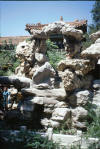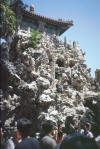|
The Ming Dynasty
"In 1368, a popular uprising drove out the
Mongol rulers, and
from that date until 1644, the native Ming dynasty ruled China. During
this time, court painting flourished and important regional schools emerged.
The Ming court's lavish appetite for luxury goods also gave new impetus to
brilliant technical achievement in the decorative arts."
- Gardner's
Art Through The Ages,
11th edition, Vol. II, p. 807
***************************************************

View looking up the slope of the Great Wall

View looking down the slope of the Great Wall
***************************************************
"The conservatism of Confucian China, as expressed in its
architecture, can be seen in the Taihe Dian (Hall of supreme harmony), one of
the principal monuments of the Ming and Qing dynasties. The Taihe Dian is
the largest building and centerpiece of the grand, typically axial design of the
"Forbidden City" in China's capital, Beijing. The former Imperial Palace
compound is known as the Forbidden City because only the emperor's closest
family members, attendants, and advisors could enter there. The compound
itself is centered on Beijing's north-south axis."
- Gardner's
Art Through The Ages,
11th edition, Vol. II, pp. 811 - 812
 Taihe Dian - Hall of Supreme Harmony
Taihe Dian - Hall of Supreme Harmony
"The great hall functioned as the emperor's throne room
and audience hall. Built in 1627, rebuilt in 1697, and restored in 1765,
it is a late and monumental example of the persistence of the standard Chinese
architectural style. Of great scale, some two hundred feet long and one
hundred feet deep, it has a weighty, majestic formality appropriate for the
staging of sacred imperial ceremonies. Raised high on a terraced white
marble podium, the massive wooden structure, with its overhanging eaves and
upturned roof lines, dominates several smaller halls flanking it symmetrically
and grouped behind it. "
- Gardner's
Art Through The Ages,
11th edition, Vol. II, p. 812
 Moat and Auxiliary Buildings
Moat and Auxiliary Buildings
"Repeating the design of Taihe Dian, these halls
with their hipped roofs and upswept eave lines align with the north-south axis
running through the rectangular moat-surrounded imperial compound. The
auxiliary halls, with their courtyards, provided the imperial family's private
quarters, service quarters, harems, places for study, gardens and spaces
enclosed for the innumerable activities of elaborate court life. The whole
immense composition is faithfully laid out according to rules for design and
structure set down and followed for more than a millennium."
- Gardner's
Art Through The Ages,
11th edition, Vol. II, p. 812
 Exterior Moat at Night
Exterior Moat at Night
Entry Gate to the Forbidden City (with
Portrait of Mao)

Guardian Lion Figures in the Forbidden City

Taoist Gardens in the heart of the Forbidden City


"The Chinese logogram for garden provides its definition -
'a place enclosed by walls, within which are buildings, waterways, rocks, trees,
and flowering plants.' ... Garden design is a great art, akin to composing a
poem or a landscape painting. It is not a matter of cultivating plants in
rows or of laying out terraces, parterres (raised flower beds), and avenues in
geometric fashion. Chinese gardens are rather cunningly contrived scenic
arrangements of natural and artificial elements intended to reproduce the
irregularities of uncultivated nature. ... A favorite garden element,
fantastic rockwork, represents primitive nature and, ideally, should be
'grotesque, spare, and porous.' ... Chinese gardens are sanctuaries where people
commune with nature in all its representative forms and as an ever-changing and
boundless presence."
- Gardner's
Art Through The Ages,
11th edition, Vol. II, p. 811
***************************************************

Temple of Heaven, Beijing
***************************************************

South Entrance Gate in the city of Xian

Guard Tower on the city walls of Xian
****************************************************
"... down from the library came a loud ping
From a vase which was commonly said to be Ming -
Then the family would say: "Now which was that cat?"
- T. S. Eliot: Mungojerrie and Rumpelteazer
from Old Possum's Book of Practical Cats

(photo credit: Clay Levering)
|